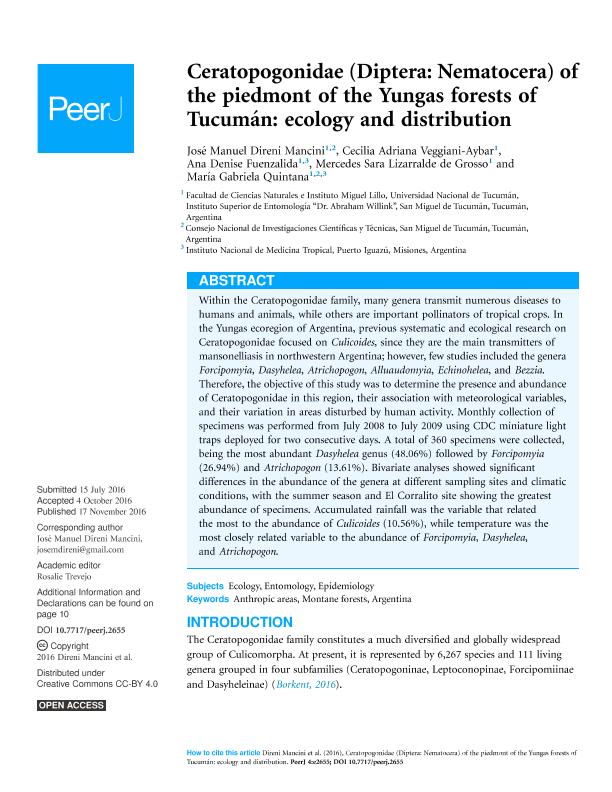Artículo
Ceratopogonidae (Diptera: Nematocera) of the piedmont of the Yungas forests of Tucumán: ecology and distribution
Direni Mancini, José Manuel ; Veggiani Aybar, Cecilia Adriana
; Veggiani Aybar, Cecilia Adriana ; Fuenzalida, Ana Denise; Lizarralde de Grosso, Mercedes Sara; Quintana, María Gabriela
; Fuenzalida, Ana Denise; Lizarralde de Grosso, Mercedes Sara; Quintana, María Gabriela
 ; Veggiani Aybar, Cecilia Adriana
; Veggiani Aybar, Cecilia Adriana ; Fuenzalida, Ana Denise; Lizarralde de Grosso, Mercedes Sara; Quintana, María Gabriela
; Fuenzalida, Ana Denise; Lizarralde de Grosso, Mercedes Sara; Quintana, María Gabriela
Fecha de publicación:
11/2016
Editorial:
PeerJ Inc.
Revista:
PeerJ
ISSN:
2167-8359
Idioma:
Inglés
Tipo de recurso:
Artículo publicado
Clasificación temática:
Resumen
Within the Ceratopogonidae family, many genera transmit numerous diseases tohumans and animals, while others are important pollinators of tropical crops. Inthe Yungas ecoregion of Argentina, previous systematic and ecological research onCeratopogonidae focused onCulicoides, since they are the main transmitters ofmansonelliasis in northwestern Argentina; however, few studies included the generaForcipomyia, Dasyhelea, Atrichopogon, Alluaudomyia, Echinohelea, and Bezzia.Therefore, the objective of this study was to determine the presence and abundanceof Ceratopogonidae in this region, their association with meteorological variables,and their variation in areas disturbed by human activity. Monthly collection ofspecimens was performed from July 2008 to July 2009 using CDC miniature lighttraps deployed for two consecutive days. A total of 360 specimens were collected,being the most abundantDasyheleagenus (48.06%) followed byForcipomyia(26.94%) andAtrichopogon(13.61%). Bivariate analyses showed significantdifferences in the abundance of the genera at different sampling sites and climaticconditions, with the summer season and El Corralito site showing the greatestabundance of specimens. Accumulated rainfall was the variable that relatedthe most to the abundance of Culicoides(10.56%), while temperature was themost closely related variable to the abundance ofForcipomyia, Dasyhelea,andAtrichopogon.
Palabras clave:
Anthropic areas
,
Montane forests
,
Argentina
Archivos asociados
Licencia
Identificadores
Colecciones
Articulos(CCT - NOA SUR)
Articulos de CTRO.CIENTIFICO TECNOL.CONICET - NOA SUR
Articulos de CTRO.CIENTIFICO TECNOL.CONICET - NOA SUR
Articulos(UEL)
Articulos de UNIDAD EJECUTORA LILLO
Articulos de UNIDAD EJECUTORA LILLO
Citación
Direni Mancini, José Manuel; Veggiani Aybar, Cecilia Adriana; Fuenzalida, Ana Denise; Lizarralde de Grosso, Mercedes Sara; Quintana, María Gabriela; Ceratopogonidae (Diptera: Nematocera) of the piedmont of the Yungas forests of Tucumán: ecology and distribution; PeerJ Inc.; PeerJ; 4; e2655; 11-2016; 1-14
Compartir
Altmétricas



